The Shell Building and all its Crimes

Image from Onze geschiedenis | Shell Nederland
The Shell Building by J.J.P.Oud was a building that was both ahead and behind the times when it was built. A building that irrevocably damaged the reputation of its designer for the crime of adding ornamentation but has perhaps unfairly not been reappraised since it was finished.
Background
Philip Johnson the Sith Lord of architecture would cite three moments that turned him towards the profession. A visit to Chartres Cathedral as a thirteen years old, a visit to the Parthenon in 1928, and a small row of workers houses in the Hoek van Holland by J.J.P.Oud.
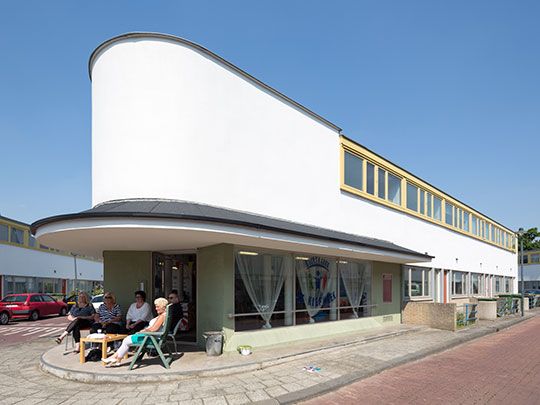
De-Kiefhoek Workers Housing (photo from Urbanguides.nl)
Later as a young man in 1930-31, Johnson with Henry-Russell Hitchcock made a European excursion investigating a new type of architectural style that was emerging there at the time. They set about visiting and collecting projects for what would later become the first the exhibition then the catalog and 1932 book The International Style : Architecture since 1922. Johnson under the umbrella The International Style thus rebranded and launched modernism to the broader world.
It was work mostly from De Stijl, Bauhaus, Deutscher Werkbund , Corbusier and the group around the L’Esprit Nouveau magazine. This had previously been loosely called Functionalism, but Johnson took this and extended the scope to include for instance Aalto, Neutra and Frank Lloyd Wright among others.
Three slogans came to sum up the style;
ornament is a crime, truth to materials , form follows function
All of these Architects are still household names today, a hundred years on, but J.J.P.Oud ? Well not so much. What happened to him and his reputation? Well the Shell building happened.
Oud and Johnson Meet
After Oud had met Johnson on his European tour of 1930-31 they kept in touch writing to one another regularly. Initially about Oud’s design of a House in Pinehurst, North Carolina for Johnson’s mum and the model of that house which would form a key part of the MOMA Exhibition.
The exhibition and following book were a huge success and helped to frame the eventual rise of modernism after WWII with Johnson as gatekeeper to the international avant-garde.
But all this was still to happen in the future. First as your can read in The Man in the Glass House Johnson turned his back on Architecture to fully embrace far right fascist politics even starting his own Nazi party.
Only when these plans came to nought and the U.S.A. entered on the wrong side of the war would Johnson turn back to Architecture and Design.
The Shell Building
In 1938, Oud won the commission to design the headquarters of the Bataafse Importmaatschappij (BIM), later Shell, in The Hague. Interrupted by the onset of WWII it would be finished in 1948. The design differs from Oud’s earlier work in its rather traditional appearance with Neo-Classical elements. J.J.P Oud called the project ‘a step forward’ but the building’s reception by the Architectural community buried forever the reputation of the foremost Architect of the De Stijl movement.
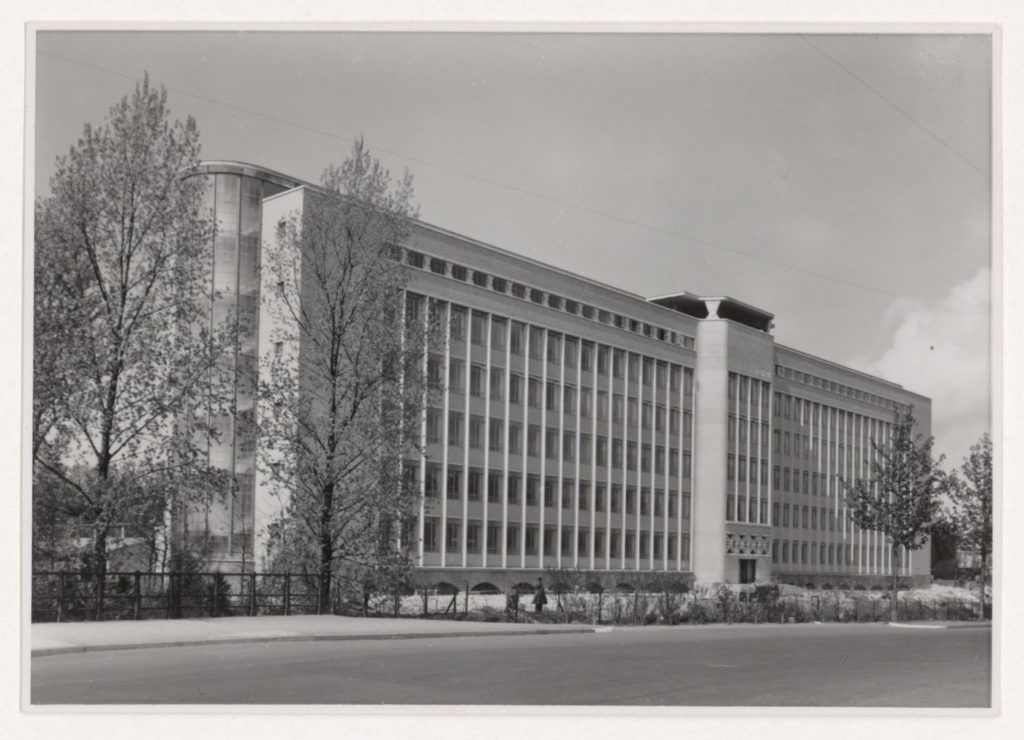
View of the principal façade of the Shell Building, The Hague, Netherlands. Collection Centre Canadien d’Architecture/ Canadian Centre for Architecture, Montréal link
The Building marks a return for Oud to a more formal design. It is perpendicular to the road, symmetrical and incorporates neo-classical decoration partly inspired by references to the client’s
layout of the floor plans, treatment of windows and staircases at either end which are glazed is not typically neo-classical but much more recognisably ‘modern’.

Ground floor plan for the Shell Building, The Hague, Netherlands Collection Collection Centre Canadien d’Architecture/ Canadian Centre for Architecture, Montréal link
Johnson and Oud Correspondance
After the War Johnson and Oud took up their correspondence again. Oud sent photographs of the Shell building to Johnson who was to forward them on for publishing, Johnson wrote back on 25 November 1945:
I do not know what to say. Maybe I ought to wait until I can see you and we can talk over the whole thing together. Frankly, to me the building looks like a return to Dutch tradition rather than the next step in international architecture. It is International only if Berlage was an International architect. No one but a Dutchman would have built it just that way. That is fine, but why call it International?’
Oud replied on 18 December 1945:
’We have to explore always new terrains. I myself am sure that I did a bit of this in the Shell-building again and I hope that you too will find after studying it that I am right. If it is “conventional” to use anew the rules that as long as this world rolls had reigned good architecture than I am glad that I am “conventionally”
See below for the correspondence covering the Shell building taken from the book Mart Stam’s trousers.
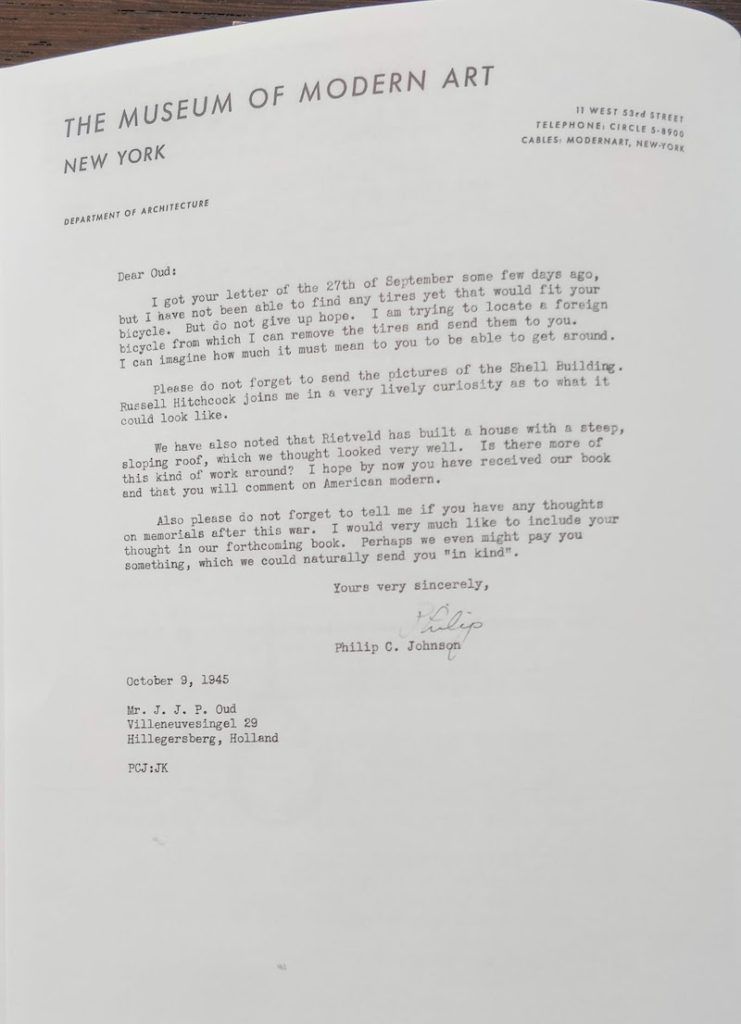
Johnson to Oud 9th October 1945
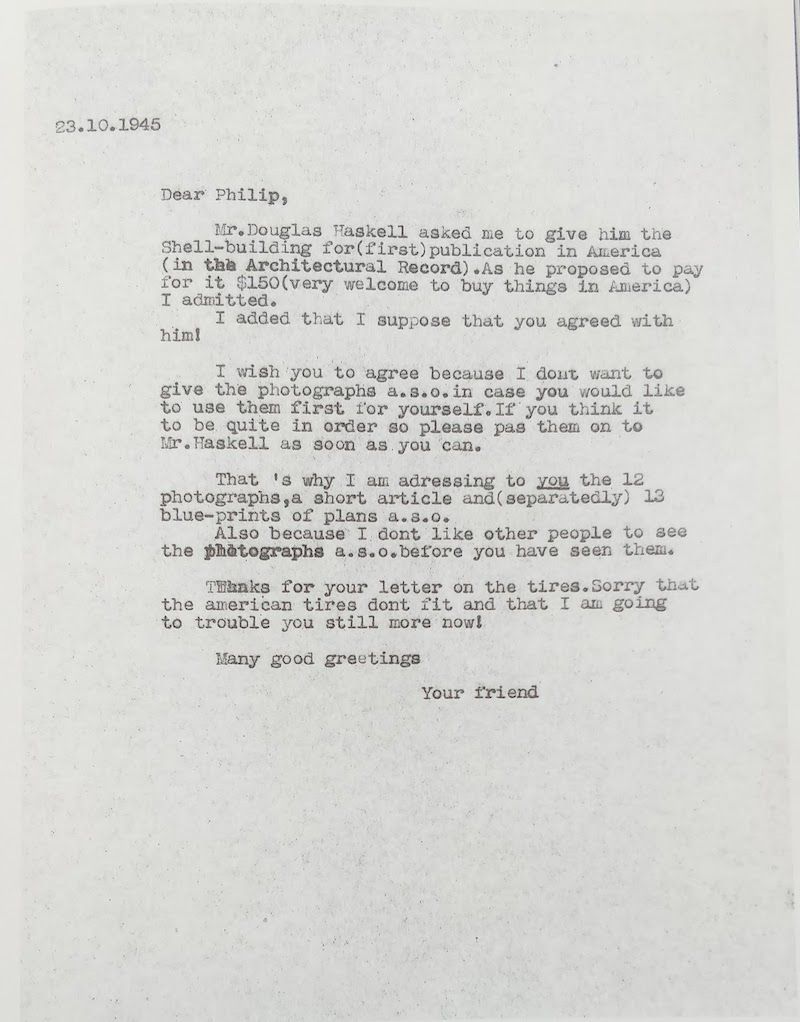
Oud tho Jonhson 23rd October 1945

Johnson to Oud 25th November 1945
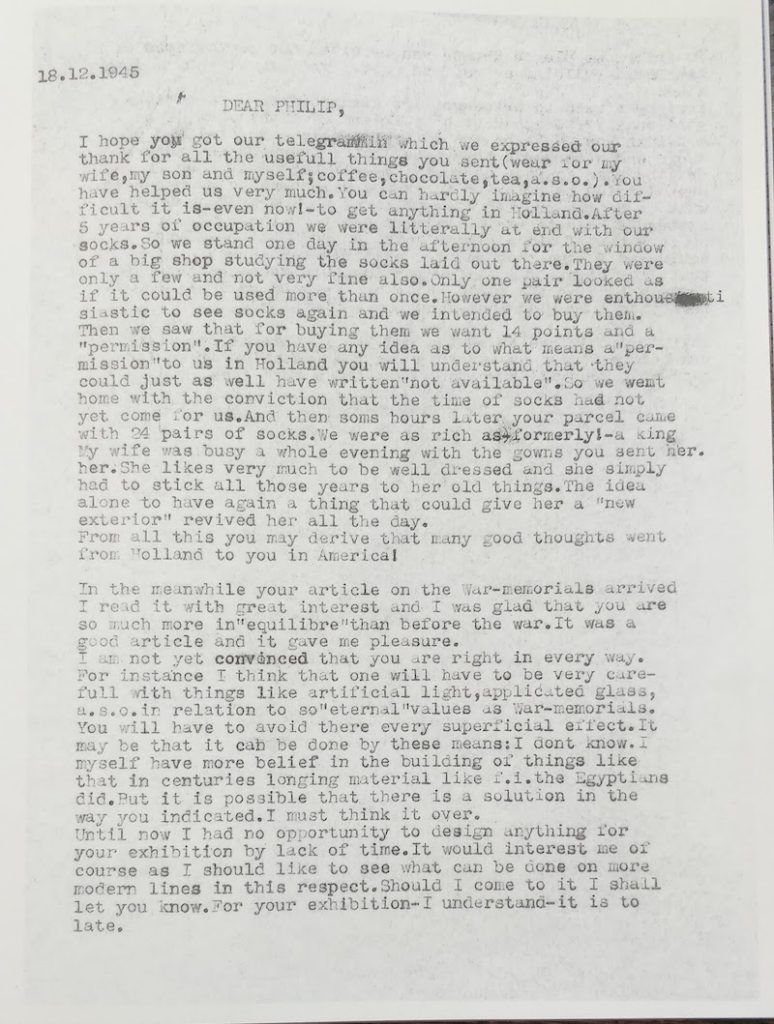
Oud to Johnson 18th December 1945 part 1

Oud to Johnson 18th December 1945 part 2
Reception
It’s probably true that Oud lost his reputation and it never really recovered. The Shell building was published in the Architectural Record and was heavily critised and then also in Europe.
It wasn’t just Johnsons doing either he had appeared to most critics to have betrayed the very principles just a few years earlier he had set up. As can be read from the correspondence Johnson seems genuinely disappointed to dislike the building.

J.J.P. Oud. Headquarters of the Bataafsche Import Maatschappij, The Hague, 1938-1942. Ornament on the roof of the building. Collection Het Nieuwe Instituut, OUDJ ph535
While everyone was loosing it over the decorations and the formal composition they didn’t seemingly take time to see a modern approach to planning and layout or a mix of modern technology with a little more traditional formalism. It was Post-Modern before the term had been invented.
Letter to Ayn Rand
An interesting aside is that Oud wrote Ayn Rand a fan letter after reading The Fountainhead, after which she requested and received an autographed photo of this building. As can be, I think, understood from the reply by Rand, Oud is perplexed and unhappy about the reception the Shell building has received.
Below is the letter from Rand to Oud:
September 22, 1947
Dear Mr. Oud:
Thanks you for your letter and for the autographed pictures of your buildings which I have just received. They have made me very happy, and if you have enjoyed The Fountainhead, we are now even.
I admire your buildings very much. I think the Houses in Hook of Holland are one of the best examples of workers’ housing architecture. But I agree with you, that your Shell building is a step forward. I did not read the article you mentioned in Architectural Record, but I read your answer to them, which you sent me, with great interest. I can see that they criticized you precisely for the best things about the Shell building- for the fact that it is beautiful. In the booklet which you sent me, I admire your detail, the design of the brick work on what I believe is a rear entrance, and the design of the column in the photograph of the gallery.
I suppose you know in your battle with the alleged modernists who object to ornament, is the battle of an abstraction against minds who, like animals, can understand nothing but concrete and are unable to grasp the principle involved. Your abstract principle is the same both in the Shell building and in the workers’ houses, but the mentality of the Collectivists cannot understand that. They are anxious to stop at specific forms and consider them general rules, so that they may then steal them and copy them. Hey do not understand (or don’t want to understand) that the only rules possible in any art are abstract principles, whose specific translation into a concrete form has to be created by the artist and has to be new each time, in each particular case. You can see why they would not like that. They are able to do nothing except to copy the ready-made forms of others. My compliments to you for your battle and my best wishes that you win it, as, of course, you will.
- Letter copied from the Book Letters of Ayn Rand: Rand, Ayn, Berliner, Michael S., Peikoff
Post-Modernism
At least Ed Taverne argues that his Shell building is a logical progression of his work from before, me I don’t know, I can’t see it alone from the building and don’t know enough about the work of Oud to say.
I think programmatically his may be true, aesthetically he could be looking to integrate some of the newer construction techniques back into a more contiguous style.
It is worth noting that other Architects of the time like Zholtovsky, Bonatz, Asplund or Lutyens working in the Neo-Classical style are doing similar work. It’s probably fair to say it’s the case that Oud’s early work is so influential for Functionalism that he effectively cast himself out from his biggest supporters and fans.
Ed Taverne has also said that Ouds later work anticipates post-modernism style in some ways, and I couldn’t agree more. Perhaps looking at contemporary neo- classical work of the time and trying to look for continuation in style we could say that Post-Modernism in architecture in some ways even predates Modernism.
Johnson The Kingmaker
Johnson later would endorse the Post-Modern theories of Denise Scott Brown and Robert Venturi, see Learning from Las Vegas published in 1972, and this would mark the death of the modern era of Architecture. A little ironic as with the Shell building he had already killed Post-Modernism thirty years before.
Details
- Shell Headquarters, The Hague
- 1938-1948
- Address: Wassenaarseweg 80, 2596 CZ Den Haag, Netherlands
- Architect: J.J.P Oud
- The building still exists but Shell is no longer its tennant.
Further Reading
- Mart Stam’s Trousers A sadly out of print book which is a lovely collection of essays that cover easy modernism in the Netherlands. The Chapter Mr.Oud Looses Ornament Correspondence between Philip Johnson and J.J.P.Oud 1931-55 by Dolf Broekhuizen sparked my interest in this building.
- The Biography of Philip Johnson The Man in the Glass House is a great read and provides invaluable background of this fascinating time.
- J.J.P. Oud’s Shell Building: Design and Reception: Broekhuizen, Dolf, Taverne, Ed, Oud Ed Taverne is an Architecture Lecturer at the University of Groningen and is the authority on this building.